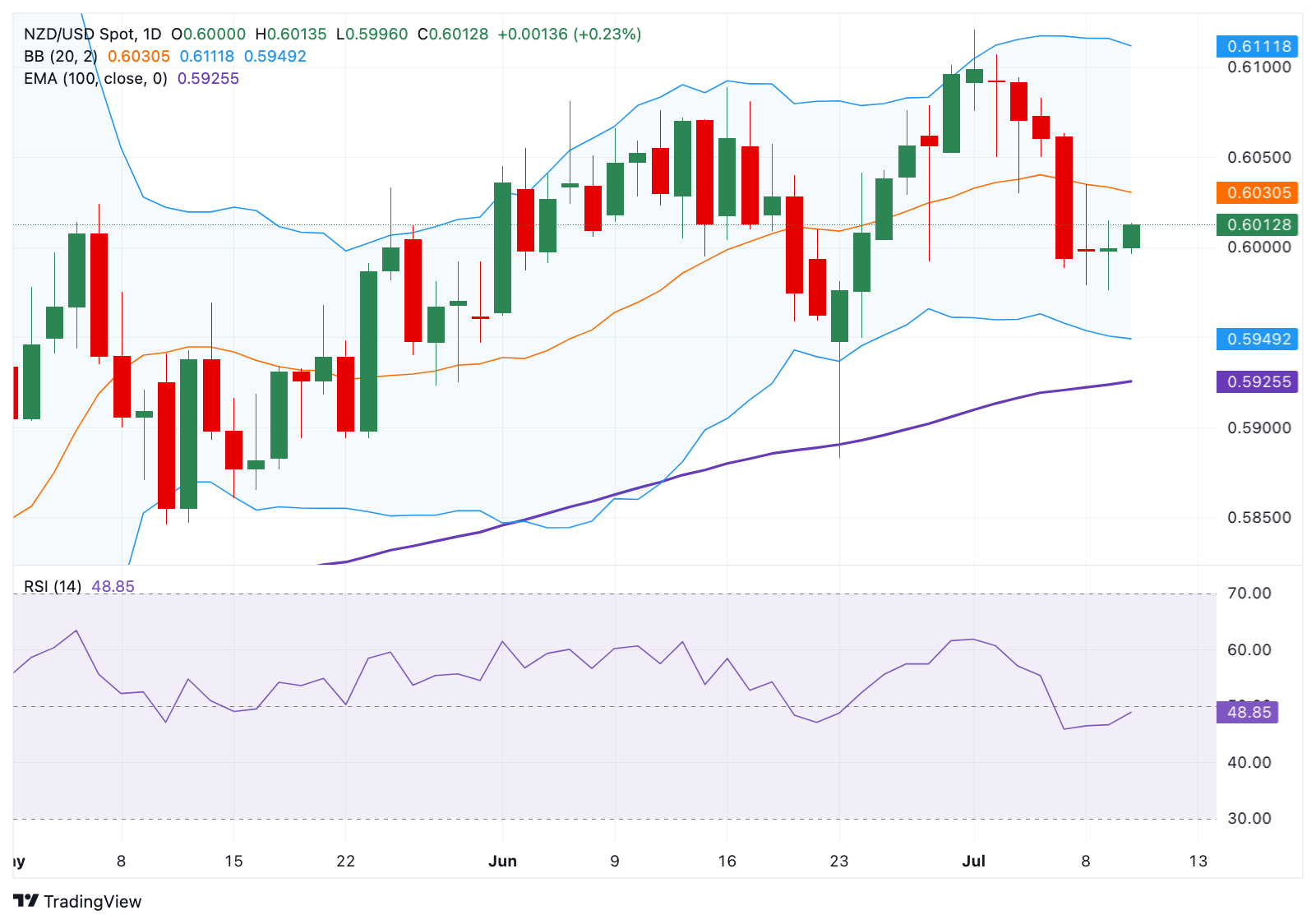NZD/USD Price Forecast: Retains bullish bias above 0.6000 above the 100-day EMA
- NZD/USD gains momentum to around 0.6010 in Thursday’s early European session, up 0.20% on the day.
- The pair keeps the bullish vibe above the 100-day EMA, but consolidation cannot be ruled out in the near term.
- The immediate resistance level is seen at 0.6072; the initial support level is located at 0.5976.
The NZD/USD pair attracts some buyers near 0.6010 during the early European session on Thursday, bolstered by a softer US Dollar (USD). The US weekly Initial Jobless Claims will be in the spotlight later on Thursday. Also, the Federal Reserve (Fed) officials are scheduled to speak, including Alberto Musalem, Christopher Waller and Mary Daly.
The RBNZ left the Official Cash Rate (OCR) unchanged at 3.25% at its July meeting on Wednesday. Policymakers said the decision to hold the interest rate would allow the central bank to assess whether weakness in the domestic economy is persisting and how inflation and inflation expectations evolve before their next meeting in August.
Technically, NZD/USD keeps the bullish vibe on the daily chart, with the price holding above the key 100-day Exponential Moving Average (EMA). However, further consolidation cannot be ruled out as the 14-day Relative Strength Index (RSI) hovers around the midline. This suggests neutral momentum in the near term.
The first upside target to watch for the pair is seen at 0.6072, the high of June 12. Extended gains could see a rally to the 0.6100-0.6110 zone, representing the psychological mark and the upper boundary of the Bollinger Band. Further north, the next hurdle is located at 0.6173, the high of October 7, 2024.
On the other hand, the initial support level for NZD/USD emerges at 0.5976, the low of July 9. A breach of this level could expose 0.5950, the lower limit of the Bollinger Band. The crucial contention level to watch is 0.5925, the 100-day EMA.
NZD/USD Daily Chart

New Zealand Dollar FAQs
The New Zealand Dollar (NZD), also known as the Kiwi, is a well-known traded currency among investors. Its value is broadly determined by the health of the New Zealand economy and the country’s central bank policy. Still, there are some unique particularities that also can make NZD move. The performance of the Chinese economy tends to move the Kiwi because China is New Zealand’s biggest trading partner. Bad news for the Chinese economy likely means less New Zealand exports to the country, hitting the economy and thus its currency. Another factor moving NZD is dairy prices as the dairy industry is New Zealand’s main export. High dairy prices boost export income, contributing positively to the economy and thus to the NZD.
The Reserve Bank of New Zealand (RBNZ) aims to achieve and maintain an inflation rate between 1% and 3% over the medium term, with a focus to keep it near the 2% mid-point. To this end, the bank sets an appropriate level of interest rates. When inflation is too high, the RBNZ will increase interest rates to cool the economy, but the move will also make bond yields higher, increasing investors’ appeal to invest in the country and thus boosting NZD. On the contrary, lower interest rates tend to weaken NZD. The so-called rate differential, or how rates in New Zealand are or are expected to be compared to the ones set by the US Federal Reserve, can also play a key role in moving the NZD/USD pair.
Macroeconomic data releases in New Zealand are key to assess the state of the economy and can impact the New Zealand Dollar’s (NZD) valuation. A strong economy, based on high economic growth, low unemployment and high confidence is good for NZD. High economic growth attracts foreign investment and may encourage the Reserve Bank of New Zealand to increase interest rates, if this economic strength comes together with elevated inflation. Conversely, if economic data is weak, NZD is likely to depreciate.
The New Zealand Dollar (NZD) tends to strengthen during risk-on periods, or when investors perceive that broader market risks are low and are optimistic about growth. This tends to lead to a more favorable outlook for commodities and so-called ‘commodity currencies’ such as the Kiwi. Conversely, NZD tends to weaken at times of market turbulence or economic uncertainty as investors tend to sell higher-risk assets and flee to the more-stable safe havens.
